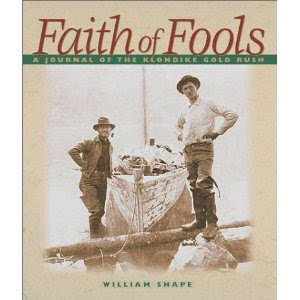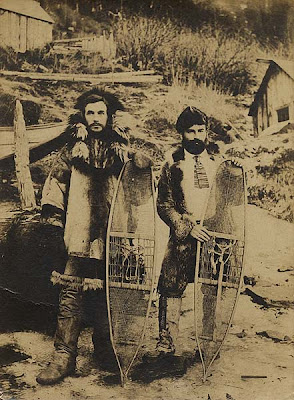Today is the anniversary of the night when the Titanic struck an iceberg and sank in the wee hours of the 15th of April 1912.
I cannot speak any more eloquently of the bravery of Officer Lightoller during that night as the blog post by Dr. Grumpy:
http://drgrumpyinthehouse.blogspot.com/
I was surprised to hear that Lightoller was another goldrusher here in 1898 but it makes sense, the men and women who were drawn to the drama of the Klondike were a special breed!
“Clearing Out Sale”

posted in the local paper on October 3, 1905:
“I am closing out for cash the following articles:
8 fine dogs – well broken to harness
16 pairs of fine Pennington wool mills woolen blankets
1 large Polar bear skin
1 buggy which would be well suited for a delivery wagon.
These are bargains for those that want them.
William Moore
Moore’s Park.”
Chinese
Joseph Dewitt Matlock

Born on this day, March 8, 1839 in Benton County Tennessee, Joseph grew up in a large farming family in Tennessee and Missouri. The family crossed the country in an ox-driven covered wagon in 1853 on the Oregon Trail and they settled in Pendleton, Oregon. His brothers all had ranches and became involved in politics.
He joined the gold rush in January, 1898, going first to Skagway, after which he engaged in business at Lake Bennett, British Columbia, for two years. He sold out there with the intention of moving his stock to Dawson and proceeded down the Yukon river, taking his goods with him on flatboats. While en route he lost about two thousand dollars through the sinking of a boat in a storm, for, although he succeeded in raising the boat, the stock was almost worthless. In Dawson he again embarked in general merchandising but after eighteen months closed out his store there and returned to Eugene, making the trip down the Yukon river to St. Michael and thence to Nome.
His brother William stayed in Skagway a little longer establishing the Idaho Saloon, the Midway Saloon, and was president of the Skagway Brewing Co. Saloon but he also left for the Yukon in 1899 and later returned to Pendleton, Oregon.
Joseph died in 1921 in Lane County, Oregon at the age of 82 surrounded by his 12 children. William also died there in 1914.
Seen above is the corner of 3rd and Broadway, the building on the corner, across the street from the Golden North and next to the Sweet Tooth Cafe is the building which once housed the Idaho Saloon.
Gaston, Joseph. “The Centennial History of Oregon, 1811-1912.” Vol. 4. Chicago, Clarke Publishing Co., 1912. p. 355; Oregon death index.
William Herrmann Shape

William Shape was born on this day, March 1, 1867 in Milwaukee to a hard working Wisconsin family. His mother and father were from Germany and his father ran a beer bottling plant. The middle child of a brood of 8, he was well schooled and had traveled widely in Europe before he left his wife and two children to seek even greater wealth in the Klondike.
George Edward Carson

George E. Carson was born in 1846 in Maryland. He moved to Indiana where he met and married Matilda. They had two sons and a daughter there from 1876 to 1886. In 1898 they all moved to Skagway. In February 1898, as the U.S. Customs officer, he logged in five thousand stampeders.
In Skagway and Dyea he had help from U.S. Customs officers William Denny, Lewis C. Harman, C.L. Hobart, I. Myre Hoffstad, J.W. Ivey, A.I. Jones, DeWitt P. Lea, L.S. Luke, Oliver McCulloch, Thomas G. Payne, William H. Robertson, W.H. StClair, Clarence Leroy Andrews, R.W. Bellman, and others in later years.
Georg’s son, George C. also worked for U.S. Customs in Skagway in 1906 and the family stayed until George E. died on February 20, 1931 in Skagway. He is buried in the Pioneer Cemetery.
Seen above is City Hall in Skagway, it is perhaps where the Customs had their office, but maybe not.
Bill Gates and the eggs

“Swiftwater Bill” Gates, or Charles H. Gates was born in 1855 in Minerva New York. He was working as a boatman in Idaho in 1896 when he decided to go to Alaska. He and some partners leased “Thirteen El Dorado” which later paid out and made him a millionaire. Enjoying his new wealth, he would walk the streets of Dawson in top hat, white shirt and jacket (and said to bathe in champagne). He apparently loved women and gambling. He had the hots for Miss Gussie Lamore in Dawson and offered her her weight in gold to marry him. She however spurned him, and was seen in the restaurant with a new boyfriend ordering fried eggs – the most expensive item on the menu. So, to get even, Bill bought up all the eggs in Dawson and fed them to dogs, in another version fed them to the other dance hall girls. Miss Gussie loved eggs and so he hoped to get her attention. Apparently it worked as she offered to meet him in San Francisco and marry him (despite already being married). He married her younger sister, Grace, then divorced her and remarried and divorced several times in the next few years.
Swiftwater Bill was known to be at the gold fields of Nome, Alaska at the same time as William H. Gates I, grandfather of the Microsoft founder. However, despite the similarity in name and coincidences of geography, there is no apparent family relationship between “Swiftwater Bill” and Microsoft founder Bill Gates.
In any event, some versions say that in 1933 he went to Peru and was mining silver there, when on this date, February 13, 1933 he died in mysterious circumstances, perhaps murder…..another account says he was murdered on February 21, 1937 and still another that he died of pneumonia following surgery back in Neillsville, Clark County, Wisconsin on February 13, 1933.
In any event, he certainly lived an exciting life.
Seen above with Joe Boyle-left, “Swiftwater Bill” on the right.
Source: Neillsville Press (Neillsville, Clark County, Wis.) 16 Feb. 1933 obituary of “Swiftwater Bill” Gates.
http://wvls.lib.wi.us/ClarkCounty/clark/data/1/bbs16/16906.htm
First woman over White Pass trail

On July 24, 1897 the Juneau Searchlight reported that a Mrs. Ed Lord claimed to be the first woman to climb the White Pass as she got off the Steamship Rustler. I believe that she was not married to Edward Eldridge Lord (born July 9, 1874) who traveled with his brother Joseph Lord (born July 31, 1864) of Hornitas, Mariposa County, California and maybe David S. Lord another brother. I think there was a mixup in the reporting and she was actually Clara Latchaw who was married to Joseph. They were part of a large family in Hornitas. Their father Samuel had come to California in the gold rush from England. So, despite the fact that they had two small children, they may have left them with family in California while they went to the Yukon.
Joseph’s obituary stated that he spent a year and a half in Alaska during the 1898 gold rush.
Edward died in 1957, Joseph in 1939, David in 1949 and Clara in 1960 – all in Fresno, California. Joseph and Clara are seen above.
Rootsweb; Yukon genealogy; familysearch; California death records; Juneau Searchlight
Ernest F. Keir

Ernest Keir was born on New Years Day, 1878 in Vernon Wisconsin.
In March 1898, Ernest and his brother set off from Wisconsin for the Yukon. Ernest used his 6.5″ x 8.5″ full-plate camera to record the trip and his stay in Dawson. Although an amateur, he managed to sell enough of his photographs, through a Dawson City drug store, to support himself in the Yukon. His biggest difficulty was in acquiring enough photographic supplies to keep in business. Keir left the north in 1900 and settled in Saskatchewan. He lost the negatives of his Yukon trip in 1913. He died also on New Years Day, 1941 and is buried in the Pines Cemetery in Spokane.
He is seen above in a cabin with some friends during the Gold Rush, he is at the far right. They are showing off their music collection of cylinders and Victrolas which helped to keep them sane in the long winters. Their version of ipods.
